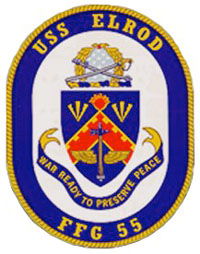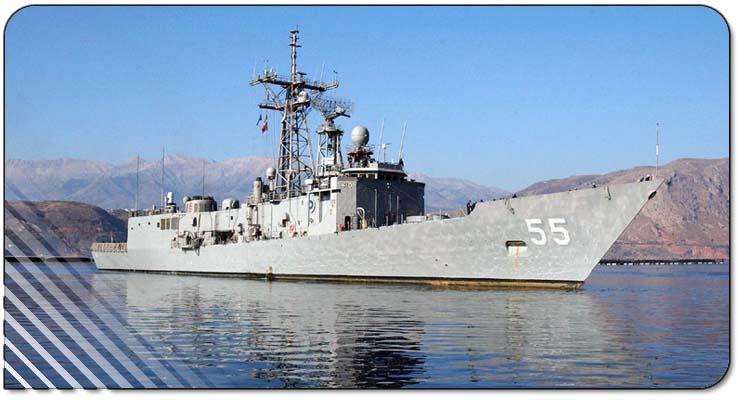Namesake:
Major Henry Talamge Elrod, USMC
Major Henry T. Elrod, U.S. Marine Corps, was born 27 September 1905, in
Turner County, Georgia. He attended the University of Georgia, and then
Yale University, until his father passed away in 1927. He enlisted in
the Marine Corps in December 1927, and was appointed a Marine Second
Lieutenant in February 1931.
On 4 December 1941, Captain Elrod flew on to Wake Island with 12
aircraft, 12 pilots and the VMF-211 ground crew. Hostilities in the air
over Wake Island commenced on 8 December 1941.
During the defense of Wake, Captain Elrod repeatedly displayed
conspicuous gallantry and intrepidity at the risk of his life, above
and beyond the call of duty. On the 12th of December he single-handedly
attacked a flight of 22 enemy planes and shot down two. On several
flights, he executed low altitude bombing and strafing runs on enemy
ships. On one of these runs, he became the first man to sink a major
warship with small caliber bombs delivered from a fighter aircraft.
When his plane was destroyed by hostile fire, he organized a group of
ground troops into a beach defense unit, and repulsed repeated Japanese
attacks. On 23 December 1941, Captain Elrod fell, mortally wounded,
while protecting his men who were carrying ammunition to a gun
emplacement.
He was posthumously promoted to Major on 8 November 1946. His widow was
presented with the Congressional Medal of Honor. This posthumous medal
was awarded to her husband for his heroic actions during the last,
bitter days of the defense of Wake Island. His widow is now Mrs.
Elizabeth Carleson.
|
Historical Notes:
USS ELROD was built at the Bath Iron Works in Maine, and was
commissioned on July 6, 1985. The ship was originally homeported in
Charleston, South Carolina and shifted to Norfolk, Virginia in March,
1995. USS ELROD has completed five deployments to the Arabian Gulf, one
to the Mediterranean Sea, and one to the Adriatic Sea, and has
participated in numerous operations in the Atlantic, Mediterranean, and
Caribbean. During the Arabian Gulf deployments, USS ELROD helped
demonstrate America’s vital interests in this region and
contributed to our naval presence during periods of hostilities as well
as calm. ELROD’s third Arabian Gulf deployment followed
Operation
DESERT STORM and supported aggressive air and surface surveillance
operations. ELROD conducted naval exercises with units of Gulf
Cooperation Council nations to strengthen and further develop the bonds
that were forged during DESERT SHIELD and DESERT STORM. The ship
participated in TEAMWORK '92, NATO’s Arctic Ocean
anti-submarine
exercise, and Operation SHARP GUARD, in support of multi-national
enforcement of United Nations sanctions and embargoing war materials to
the Balkans.
USS ELROD has also earned numerous awards during her commissioned
service, including the Joint Meritorious Unit Award, Navy Meritorious
Unit Commendation, Coast Guard Meritorious Unit Commendation, several
Battle Efficiency Excellence Awards, Secretary of the Navy Energy
Conservation Award, Armed Forces Recreation Society Award, and various
departmental and mission-specific awards for excellence. |
Ship's Crest:
 Description of Coat of
Arms:The
ship’s crest is a heraldic representation of Marine Major
Henry
T. Elrod’s heroic actions during the Battle of Wake Island in
December 1941. It was during this battle the Major Elrod was killed and
for his actions was posthumously awarded the Medal of Honor. The
colors, blue, red, and gold (yellow) are those of the Navy and the
Marine Corps. The chevron in the shield has fifteen crenellations to
represent the number of days the embattled Marines held Wake Island
against a vastly superior Japanese invasion force. The fireball in the
upper part of the shield represents major Elrod’s
single-handed
sinking of the Japanese destroyer KISARGI after being the sole U.S.
plane to penetrate a squadron of enemy fighter-bombers protecting the
Japanese battle group. Similarly, the pheons on both sides of the
fireball represent the two Japanese planes shot down by Major Elrod.
The broken aviators wings and the war hammer symbolize Major
Elrod’s further distinguished actions in ground combat after
all
the aircraft in his squadron had been destroyed. The hammer also
signifies the destructive force of the guided missile frigate ELROD.
Major Elrod’s service as a Marine Officer is symbolized by
the
unsheathed mameluke sword, which also draws attention to the fact the
he was among the first to engage the Japanese in World War II. The blue
background and thirteen stars represent the Medal of Honor awarded to
Major Elrod for his heroic actions on Wake Island. The gold wreath,
pointed downward, commemorates his honorable death in action. Description of Coat of
Arms:The
ship’s crest is a heraldic representation of Marine Major
Henry
T. Elrod’s heroic actions during the Battle of Wake Island in
December 1941. It was during this battle the Major Elrod was killed and
for his actions was posthumously awarded the Medal of Honor. The
colors, blue, red, and gold (yellow) are those of the Navy and the
Marine Corps. The chevron in the shield has fifteen crenellations to
represent the number of days the embattled Marines held Wake Island
against a vastly superior Japanese invasion force. The fireball in the
upper part of the shield represents major Elrod’s
single-handed
sinking of the Japanese destroyer KISARGI after being the sole U.S.
plane to penetrate a squadron of enemy fighter-bombers protecting the
Japanese battle group. Similarly, the pheons on both sides of the
fireball represent the two Japanese planes shot down by Major Elrod.
The broken aviators wings and the war hammer symbolize Major
Elrod’s further distinguished actions in ground combat after
all
the aircraft in his squadron had been destroyed. The hammer also
signifies the destructive force of the guided missile frigate ELROD.
Major Elrod’s service as a Marine Officer is symbolized by
the
unsheathed mameluke sword, which also draws attention to the fact the
he was among the first to engage the Japanese in World War II. The blue
background and thirteen stars represent the Medal of Honor awarded to
Major Elrod for his heroic actions on Wake Island. The gold wreath,
pointed downward, commemorates his honorable death in action.
|

